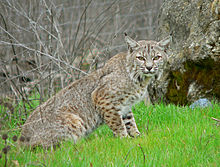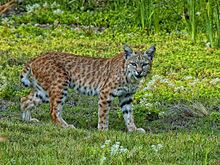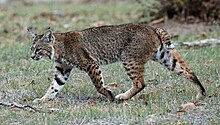| Bobcat[1] | |
|---|---|
 | |
| Scientific classification | |
| Kingdom: | Animalia |
| Phylum: | Chordata |
| Clade: | Synapsida |
| Class: | Mammalia |
| Order: | Carnivora |
| Suborder: | Feliformia |
| Family: | Felidae |
| Genus: | Lynx |
| Species: | L. rufus |
| Binomial name | |
| Lynx rufus (Schreber, 1777) | |
 | |
| Bobcat range[2] | |
| Synonyms | |
Felis rufus Schreber
| |
The bobcat (Lynx rufus) is a North American cat that appeared during the Irvingtonian stage of around 1.8 million years ago (AEO). Containing 12 recognized subspecies, it ranges from southern Canada to central Mexico, including most of the contiguous United States. The bobcat is an adaptable predator that inhabits wooded areas, as well as semidesert, urban edge, forest edge, and swampland environments. It remains in some of its original range, but populations are vulnerable to local extinction ("extirpation") by coyotes and domestic animals. With a gray to brown coat, whiskered face, and black-tufted ears, the bobcat resembles the other species of the midsized Lynx genus. It is smaller on average than the Canada lynx, with which it shares parts of its range, but is about twice as large as the domestic cat. It has distinctive black bars on its forelegs and a black-tipped, stubby tail, from which it derives its name.
Though the bobcat prefers rabbits and hares, it hunts insects, chickens, geese and other birds, small rodents, and deer. Prey selection depends on location and habitat, season, and abundance. Like most cats, the bobcat is territorial and largely solitary, although with some overlap in home ranges. It uses several methods to mark its territorial boundaries, including claw marks and deposits of urine or feces. The bobcat breeds from winter into spring and has a gestation period of about two months.
Although bobcats have been hunted extensively by humans, both for sport and fur, their population has proven resilient though declining in some areas. The elusive predator features in Native American mythology and the folklore of European settlers.
...
Physical characteristics
The bobcat resembles other species of the Lynx genus, but is on average the smallest of the four. Its coat is variable, though generally tan to grayish-brown, with black streaks on the body and dark bars on the forelegs and tail. Its spotted patterning acts as camouflage. The ears are black-tipped and pointed, with short, black tufts. Generally, an off-white color is seen on the lips, chin, and underparts. Bobcats in the desert regions of the southwest have the lightest-colored coats, while those in the northern, forested regions are darkest. Kittens are born well-furred and already have their spots. A few melanistic bobcats have been sighted and captured in Florida. They appear black, but may still exhibit a spot pattern.
The face appears wide due to ruffs of extended hair beneath the ears. Bobcat eyes are yellow with black pupils. The nose of the bobcat is pinkish-red, and it has a base color of gray or yellowish- or brownish-red on its face, sides, and back.[14] The pupils are round, black circles and will widen during nocturnal activity to maximize light reception. The cat has sharp hearing and vision, and a good sense of smell. It is an excellent climber, and swims when it needs to, but normally avoids water. However, cases of bobcats swimming long distances across lakes have been recorded.
...
The bobcat is crepuscular. It keeps on the move from three hours before sunset until about midnight, and then again from before dawn until three hours after sunrise. Each night, it moves from 2 to 7 mi (3.2 to 11.3 km) along its habitual route. This behavior may vary seasonally, as bobcats become more diurnal during fall and winter in response to the activity of their prey, which are more active during the day in colder weather.
Social structure and home range
Bobcat activities are confined to well-defined territories, which vary in size depending on the sex and the distribution of prey. The home range is marked with feces, urine scent, and by clawing prominent trees in the area. In its territory, the bobcat has numerous places of shelter, usually a main den, and several auxiliary shelters on the outer extent of its range, such as hollow logs, brush piles, thickets, or under rock ledges. Its den smells strongly of the bobcat.
...
Hunting and diet
The bobcat is able to survive for long periods without food, but eats heavily when prey is abundant. During lean periods, it often preys on larger animals, which it can kill and return to feed later. The bobcat hunts by stalking its prey and then ambushing with a short chase or pounce.... Its main prey varies by region. In the eastern United States, it is the eastern cottontail species, and in the north it is the snowshoe hare. When these prey species exist together, as in New England, they are the primary food sources of the bobcat. In the far south, the rabbits and hares are sometimes replaced by cotton rats as the primary food source. Birds up to the size of a swan are also taken, along with their fledglings and eggs. The bobcat is an opportunistic predator that, unlike the more specialized Canada lynx, readily varies its prey selection...
The average bobcat lifespan is 7 years long and rarely exceeds 10 years. The oldest wild bobcat on record was 16 years old, and the oldest captive bobcat lived to be 32.
...
The female raises the young alone. One to six, but usually two to four, kittens are born in April or May, after roughly 60 to 70 days of gestation. Sometimes, a second litter is born as late as September. The female generally gives birth in an enclosed space, usually a small cave or hollow log. The young open their eyes by the ninth or tenth day. They start exploring their surroundings at four weeks and are weaned at about two months. Within three to five months, they begin to travel with their mother. They hunt by themselves by fall of their first year, and usually disperse shortly thereafter. In Michigan, however, they have been observed staying with their mother as late as the next spring.
...
Importance in human culture
In Native American mythology, the bobcat is often twinned with the figure of the coyote in a theme of duality. Lynx and coyote are associated with the fog and wind, respectively—two elements representing opposites in Native American folklore. This basic story, in many variations, is found in the native cultures of North America ...
In a Shawnee tale, the bobcat is outwitted by a rabbit, which gives rise to its spots. After trapping the rabbit in a tree, the bobcat is persuaded to build a fire, only to have the embers scattered on its fur, leaving it singed with dark brown spots. The Mohave believed dreaming habitually of beings or objects would afford them their characteristics as supernatural powers. Dreaming of two deities, cougar and lynx, they thought, would grant them the superior hunting skills of other tribes. European settlers to the Americas also admired the cat, both for its ferocity and its grace, and in the United States, it "rests prominently in the anthology of ... national folklore."
Grave artifacts from dirt domes excavated in the 1980s along the Illinois River revealed a complete skeleton of a young bobcat along with a collar made of bone pendants and shell beads that had been buried by the Hopewell culture. The type and place of burial indicate a tamed and cherished pet or possible spiritual significance. The Hopewell normally buried their dogs, so the bones were initially identified as remains of a puppy, but dogs were usually buried close to the village and not in the mounts themselves. This is the only wild cat decorated burial on the archaeological record.









No comments:
Post a Comment